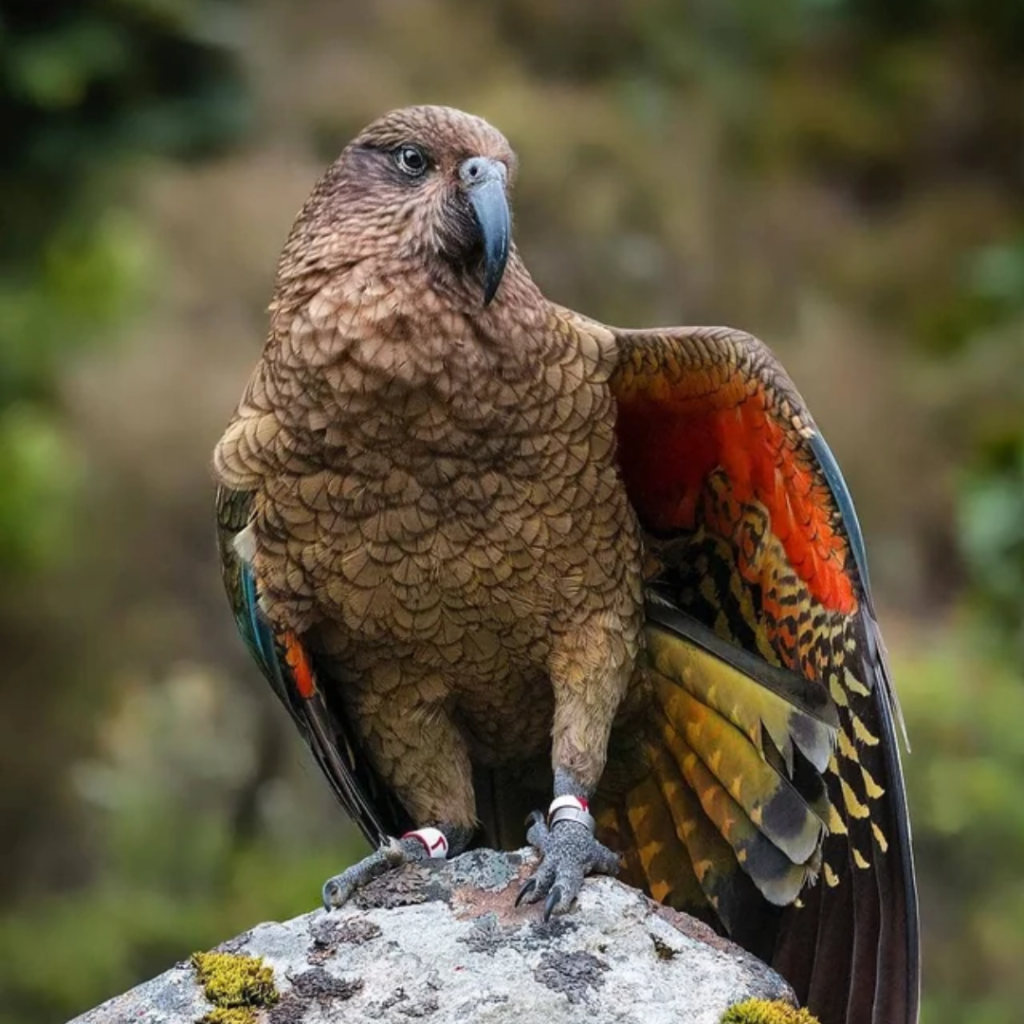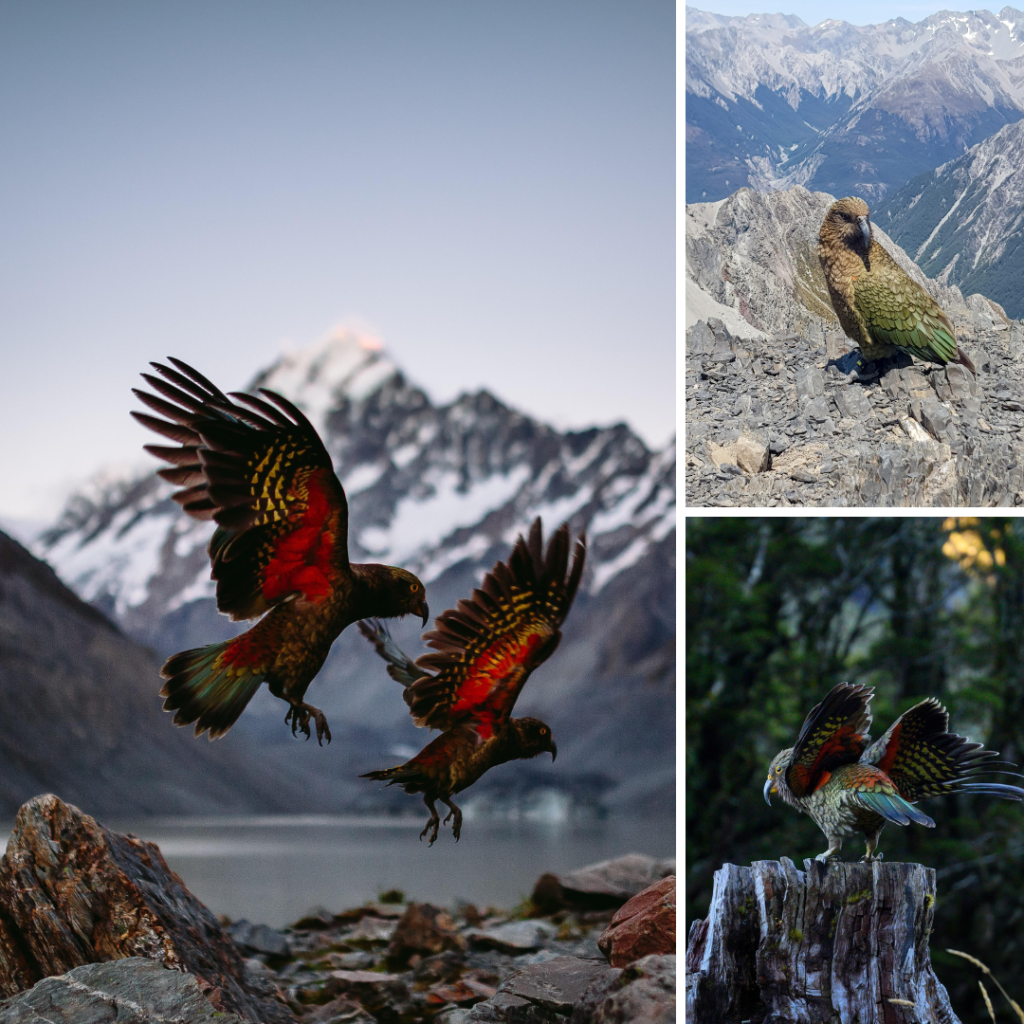

The mountainous Parrot, often known as the Kea (Nestor notabilis), is a parrot species that lives in the mountainous regions of New Zealand’s South Island. The Kea is a remarkable bird recognized for its intellect, curiosity, and playful behavior. Unfortunately, due to a multitude of challenges, the Kea is now classified as a vulnerable species, with an estimated population of only 3,000-7,000 individuals. In this post, we’ll look at the biology, habits, risks, and conservation activities of the Kea.
Kea Facts
The Kea is a large, olive-brown parrot with striking flashes of bright orange feathers under its wings. It is the world’s only alpine parrot, adapted to life in the harsh mountain environment of New Zealand’s Southern Alps. Keas are omnivorous and opportunistic feeders, eating a wide variety of foods including seeds, fruits, insects, and carrion. They are also known for their curious and mischievous behavior and are known to investigate and sometimes damage cars, backpacks, and other items left unattended in alpine parking lots and campgrounds.
Keas are also known for their intelligence and problem-solving abilities. They have been observed using tools, such as sticks to extract grubs from trees, and they can solve complex puzzles in laboratory settings. Keas are also highly social birds, living in groups of up to 13 individuals. They communicate with each other using a variety of calls and body language and have been observed engaging in cooperative behavior such as playing and grooming each other.
Kea Lifecycle
Keas reach sexual maturity at around 3-4 years of age and breed during the spring and summer months (September to January). Keas nest on the ground, typically in rock crevices or under vegetation. The female lays 2-5 eggs, which she incubates for around 21-27 days. Both parents participate in feeding and caring for the chicks, which fledge (leave the nest) at around 10 weeks of age. Keas can live up to 20 years in the wild.
Threats to Kea

The Kea faces a variety of threats to its survival, both natural and human-caused. One of the most significant threats is habitat loss and fragmentation due to human activities such as logging, farming, and urbanization. Keas are also vulnerable to introduced mammalian predators such as stoats, rats, and possums, which prey on their eggs and chicks. Climate change is also a growing threat, as rising temperatures and changing weather patterns alter the alpine habitat on which the Kea depends.
However, one of the most pressing threats facing the Kea is human persecution. Keas have a long history of being seen as a nuisance by farmers, hunters, and even conservationists. They have been blamed for damaging crops, killing livestock, and attacking native bird species. As a result, Keas have been subjected to widespread trapping, shooting, and poisoning campaigns over the years, and their numbers have declined significantly as a result.
Captive Kea
Due to their intelligence, curiosity, and playful nature, Keas have become popular attractions in zoos and wildlife parks around the world. Captive Keas provide researchers with opportunities to study their behavior and biology and to develop conservation strategies for the species. However, captivity also presents several challenges for Keas, including reduced opportunities for social interaction, lack of exercise, and stress-related behaviors such as feather plucking and self-mutilation.
To address these issues, many institutions that house Keas have developed enrichment programs aimed at providing the birds with opportunities to engage in natural behaviors and stimulate their minds.
Is Kea The Only Alpine Parrot?
The Kea (Nestor notabilis) is the only alpine parrot in the world. It is a unique parrot species adapted to live in the harsh alpine environment of the South Island of New Zealand. The Kea is well-known for its intelligence, curiosity, and playful nature, and is an essential part of New Zealand’s natural heritage.
Why Kea Is Called Alpine Parrot

The kea parrot is sometimes called the “naughty alpine parrot” because it is a highly intelligent and mischievous bird that is native to the alpine regions of the South Island of New Zealand. Kea parrots are known for their curious and playful nature, which can sometimes lead them to cause mischief and even damage property.
For example, kea parrots have been known to chew on rubber parts of cars, causing damage to vehicles, and they have been observed stealing food from backpacks and camping gear. While their behavior can be frustrating for humans, it is important to remember that kea parrots are a unique and valuable part of New Zealand’s ecosystem and should be treated with respect and care.
Can You Own A Kea Parrot?
It is not legal to own a Kea as a pet. The Kea is a protected species under New Zealand law, and it is illegal to keep them as pets or to remove them from the wild. The Kea is also listed as a vulnerable species, and efforts are underway to protect and conserve the remaining population. Anyone possessing a Kea without the proper permits and licenses can face legal consequences, including fines and imprisonment. It is important to respect the laws and regulations in place to protect this unique and endangered species.
Are kea birds extinct?
Kea birds are not extinct. However, they are classified as endangered species due to habitat loss, predation, and hunting. Kea birds are native to the South Island of New Zealand and are the only alpine parrot in the world. They are known for their intelligence, curiosity, and mischievous behavior.
Conservation efforts are being made to protect Kea birds and their habitat. In New Zealand, the Department of Conservation has implemented measures such as controlling predators and educating the public about the importance of protecting Kea birds. Additionally, research is being conducted to better understand the behavior and biology of Kea birds to develop more effective conservation strategies.
Kea Parrots Preying on Sheep
Kea parrots are known to occasionally prey on sheep in New Zealand. This behavior is rare and has been documented in only a few instances, but it can cause significant harm to sheep populations.
Kea parrots are primarily herbivores, feeding on a diet of plant material, insects, and carrion. However, they are also highly intelligent and curious birds that have been known to investigate and manipulate a wide variety of objects and environments, including sheep.
In some cases, Kea parrots have been observed pecking at the flesh of living sheep, causing injuries that can lead to infection and death. This behavior is believed to be a result of the birds’ curiosity and opportunistic feeding habits, rather than a deliberate effort to prey on the sheep.
Efforts have been made to discourage Kea parrots from preying on sheep by providing alternative sources of food and by using deterrents such as loud noises or flashing lights. Additionally, research is being conducted to better understand the behavior of Kea parrots and to develop more effective strategies for mitigating the impact of their interactions with livestock.

Leave a Reply